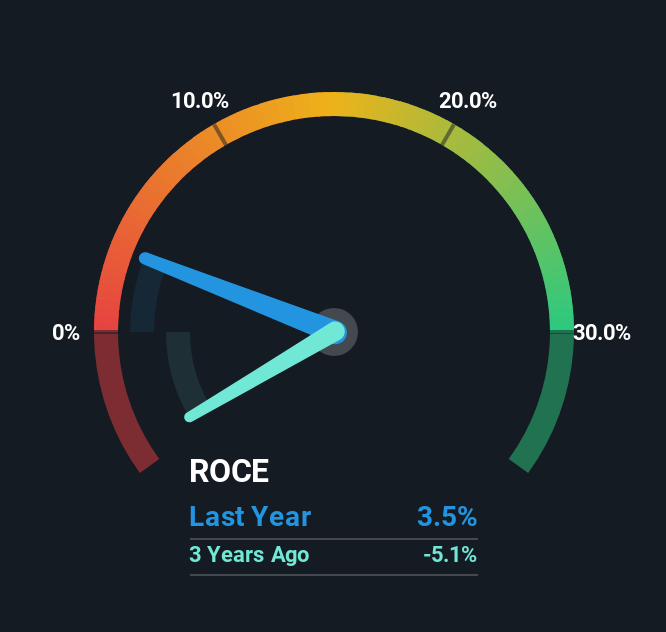- Germany
- /
- Electrical
- /
- XTRA:ENR
Siemens Energy (ETR:ENR) Shareholders Will Want The ROCE Trajectory To Continue
If you're not sure where to start when looking for the next multi-bagger, there are a few key trends you should keep an eye out for. Typically, we'll want to notice a trend of growing return on capital employed (ROCE) and alongside that, an expanding base of capital employed. Basically this means that a company has profitable initiatives that it can continue to reinvest in, which is a trait of a compounding machine. Speaking of which, we noticed some great changes in Siemens Energy's (ETR:ENR) returns on capital, so let's have a look.
Return On Capital Employed (ROCE): What Is It?
For those that aren't sure what ROCE is, it measures the amount of pre-tax profits a company can generate from the capital employed in its business. To calculate this metric for Siemens Energy, this is the formula:
Return on Capital Employed = Earnings Before Interest and Tax (EBIT) ÷ (Total Assets - Current Liabilities)
0.035 = €644m ÷ (€55b - €37b) (Based on the trailing twelve months to March 2025).
So, Siemens Energy has an ROCE of 3.5%. In absolute terms, that's a low return and it also under-performs the Electrical industry average of 8.7%.
See our latest analysis for Siemens Energy

In the above chart we have measured Siemens Energy's prior ROCE against its prior performance, but the future is arguably more important. If you'd like, you can check out the forecasts from the analysts covering Siemens Energy for free.
What Does the ROCE Trend For Siemens Energy Tell Us?
Shareholders will be relieved that Siemens Energy has broken into profitability. While the business was unprofitable in the past, it's now turned things around and is earning 3.5% on its capital. On top of that, what's interesting is that the amount of capital being employed has remained steady, so the business hasn't needed to put any additional money to work to generate these higher returns. With no noticeable increase in capital employed, it's worth knowing what the company plans on doing going forward in regards to reinvesting and growing the business. So if you're looking for high growth, you'll want to see a business's capital employed also increasing.
On a side note, we noticed that the improvement in ROCE appears to be partly fueled by an increase in current liabilities. The current liabilities has increased to 67% of total assets, so the business is now more funded by the likes of its suppliers or short-term creditors. And with current liabilities at those levels, that's pretty high.
The Key Takeaway
In summary, we're delighted to see that Siemens Energy has been able to increase efficiencies and earn higher rates of return on the same amount of capital. Since the stock has returned a staggering 543% to shareholders over the last three years, it looks like investors are recognizing these changes. In light of that, we think it's worth looking further into this stock because if Siemens Energy can keep these trends up, it could have a bright future ahead.
On the other side of ROCE, we have to consider valuation. That's why we have a FREE intrinsic value estimation for ENR on our platform that is definitely worth checking out.
If you want to search for solid companies with great earnings, check out this free list of companies with good balance sheets and impressive returns on equity.
New: Manage All Your Stock Portfolios in One Place
We've created the ultimate portfolio companion for stock investors, and it's free.
• Connect an unlimited number of Portfolios and see your total in one currency
• Be alerted to new Warning Signs or Risks via email or mobile
• Track the Fair Value of your stocks
Have feedback on this article? Concerned about the content? Get in touch with us directly. Alternatively, email editorial-team (at) simplywallst.com.
This article by Simply Wall St is general in nature. We provide commentary based on historical data and analyst forecasts only using an unbiased methodology and our articles are not intended to be financial advice. It does not constitute a recommendation to buy or sell any stock, and does not take account of your objectives, or your financial situation. We aim to bring you long-term focused analysis driven by fundamental data. Note that our analysis may not factor in the latest price-sensitive company announcements or qualitative material. Simply Wall St has no position in any stocks mentioned.
About XTRA:ENR
High growth potential with solid track record.
Similar Companies
Market Insights
Community Narratives




